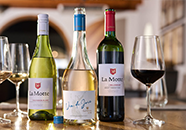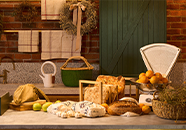Belangstelling in argitektuur / Interest in architecture
‘n Mens sou kon sê dat Pierneef se oorspronklike belangstelling in argitektuur afkomstig was van sy vader, Gerrit, wat ‘n bouer en self-opgeleide argitek was, sowel as van sy vriende Gordon Leith, Gerhard Moerdijk en Norman Eaton, wat toe bekende argitekte was. Pierneef se eerste blootstelling aan argitektuurtekenwerk was tydens sy gesin se verblyf in Nederland tydens die Anglo-Boereoorlog, van 1899 tot 1902. Op sy pa se versoek het hy ongeveer ‘n jaar lank deeltyds aandklasse in tekenwerk, wat deur ‘n argitek aangebied is, gevolg.
‘n Opsomming van Pierneef se versameling van 298 boeke oor kuns en geskiedenis, wat in 1961 aan die Universiteit van Pretoria geskenk is, toon dat Pierneef waarskynlik bekend was met boumetodes en argitektuur van die antieke Egiptenare en Grieke en dié van sý tyd. Hy was ook geïnteresseerd in kontemporêre argitektuur en boutradisies van die inheemse mense en style eie aan Suid-Afrika. Selfs al was Pierneef van mening dat die Kaaps-Hollandse argitektuur nie regtig aan Suid-Afrika behoort het nie het hy die skoonheid van Kaaps-Hollandse huise bewonder. Hierdie huise is van die mees gekose onderwerpe in sy werke met ‘n argitektoniese tema. ‘n Aansienlike getal tekeninge en linosneë wat in sommige gevalle tot pragtige, atmosferiese olieverfskilderye herskep is, is in verskeie versamelings te sien. In sulke gevalle is die onderwerpe van belang hoofsaaklik van die Tulbagh-, Somerset-Wes- en Stellenbosch-omgewing afkomstig.
Pierneef is veral bekoor deur die inheemse en volkseie style, op grond van die eenvoud van hul konstruksie en voorkoms. Hy was van mening dat daardie tipe argitektuur in balans en harmonie met die omgewing was, danksy die gebruik van beskikbare materiaal soos klip, sand, hout en riet. Voorbeelde hiervan is die hartbeeshuisies en Xhosa- en Zoeloe-hutte. Sy belangstelling in argitektuur het hom ook aangespoor om sy eie huise te bou. Die eerste hiervan was by De Waalstraat Pretoria, in 1910, gevolg deur die Pierneefs se Villieria-huis in die dertigerjare en, die grootste meesterstuk, Elangeni net buite Pretoria, in 1939.
One could say that Pierneef’s initial interest in architecture came from his father, Gerrit, who was a builder and self-taught ‘architect’, as well as from his friends Gordon Leith, Gerhard Moerdijk and Norman Eaton, who were well-known architects of that time. Pierneef’s first exposure to architectural drawing was during his family’s stay in the Netherlands during the Anglo-Boer War, from 1899 to 1902. At his father’s request, he attended part-time evening drawing classes, presented by an architect, for about a year.
A summary of Pierneef’s collection of 298 books on art and history, donated to the University of Pretoria in 1961, shows that Pierneef was probably familiar with the building methods and architecture of the ancient Egyptians, Greeks and that of his own time. Close to home, he showed interest in contemporary architecture, building traditions of the indigenous people and vernacular styles in South Africa. Even though Pierneef felt that Cape Dutch architecture did not really belong to this country, he admired the beauty of the homesteads. Cape Dutch homes are amongst the most depicted subjects in Pierneef works with an architectural theme. A substantial number of drawings and linocuts that, in some cases, were converted into beautiful atmospheric oil-paintings can be found in various collections. Here the subjects of interest originate mainly from the Tulbagh, Somerset West and Stellenbosch areas.
Pierneef was especially fascinated by indigenous and vernacular styles, on the grounds of their simplicity in construction and appearance. He felt that this type of architecture was in balance and harmony with the environment, thanks to the use of available materials such as stone, sand, wood and thatch. Examples include the ‘hartbeeshuisies’ and Xhosa and Zulu huts. His interest in architecture also inspired him to build his own houses, the first of which was at 25 De Waal Street, Pretoria, in 1910, followed by the Pierneefs’ Villeria home during the 1930s and, the masterpiece of all, Elangeni just outside of Pretoria, in 1939.
















